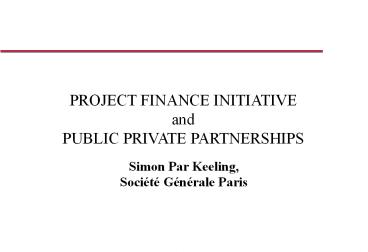PROJECT FINANCE INITIATIVE and PUBLIC PRIVATE PARTNERSHIPS PowerPoint PPT Presentation
Title: PROJECT FINANCE INITIATIVE and PUBLIC PRIVATE PARTNERSHIPS
1
PROJECT FINANCE INITIATIVE andPUBLIC PRIVATE
PARTNERSHIPS
Simon Par Keeling,Société Générale Paris
2
Public Private Partnerships
- Project Finance Initiative / Public Private
Partnership (PPPs) is a partnership between the
public sector and the private sector for the
purpose of delivering a project or a service
traditionally provided by the public sector - The overall aim of PPPs is to structure the
relationship between the public sector and the
private sector, so that the risks are borne by
those best able to manage them - Increased value is achieved for public services
through the exploitation of private sector skills
and competencies - Transfer of appropriate level of risks and
responsibility - But, government maintains control where
appropriate (e.g. regulation, transport policy)
3
Public Private Partnerships in Europe
- PPPS are increasingly being seen as an attractive
approach to the provision of infrastructure
projects and services across Europe - An ever increasing number of countries are
embarking upon PPP programmes (Greece, Ireland,
Finland, Italy) that will lead to a significant
redefinition in the role of the public sector in
the financing and provision of public services
4
Public Private Partnerships in Europe
5
Objectives of PPPs Public Sector
- Value for Money better services at lower prices
for customers - Competition - ensures that Value for Money
achieved for taxpayers - Risk Transfer
- Introducing private sector expertise
- Innovative solutions
- Off balance sheet financing and long-term private
funding
6
Implications of PPPs Public Sector
- Change in procurement process
- Development of core requirement (output
specifications, frequency of trains) - Consideration of whole-life costing
- Detailed analysis of project risks
- Regulation of the provision of services
- Relationship with funders and sub-contractors
through Direct Agreements - Consistency of approach through central
government
7
Objectives of PPPs Private Sector
- Long-term projects with strong underlying
economics - Proper risk allocation - risks that can be
managed - Acceptable returns
8
Possible Benefits derived from PPPs
- Experience of PPPs suggest that significant
benefit could be achieved in the followings areas
- acceleration of infrastructure provision / faster
implementation - reduced whole life costs
- better allocation of risk
- better incentives to perform
- improve quality of service
- generation of additional revenues for the public
sector (revenue share, concession fee)
9
Lessons learnt
- PPPs Learning the lessons
- laying the foundations (experienced external
advisors, clear regulatory regime..) - clearly defined process to reduce the time and
cost - clearly defining project and performance
requirements - removing unintended obstacles (parliamentary
appraisal, trade unions) - critical role of the central and local government
agencies to play in the management and regulation
of PPPs
10
Types of PPPs
- Wide range of options allocation of
responsibility for asset ownership, management
and capital investment between the public and
private sectors
- Private ownership, control and investment
- Incentives for efficiency
- Potential benefits for consumers
- Risk
11
Traditional Risk Allocation for Public Sector
Procurement
Roll Out
Quality/Cost
Technology
Design
Quality/Cost
Cost/Obsolescence
Cost/Availability/Terms
Public Sector
Finance
Operation
Cost/Quality
Time/Cost
Cost/Quality
Approval Process
Maintenance
Residual Value
Usage/Price
Market
Asset Value
12
Public Private Partnership Risk Allocation
Commissioning
Quality/Cost
Design
Technology
Quality/Cost
Cost/Obsolescence
Operation
Procurement Contract
Private Sector
Cost/Quality
Public Sector
Cost/Quality
Residual Value
Maintenance
Time/Cost
Cost/Availability /Terms
Usage/Price
Time/Cost
Residual Value
Finance
Approval Process
Regulatory Process
Asset Value
Demand

